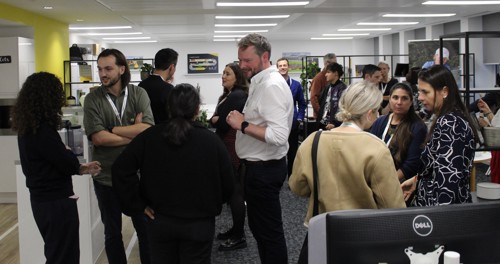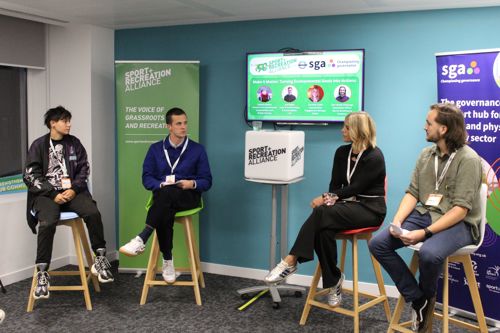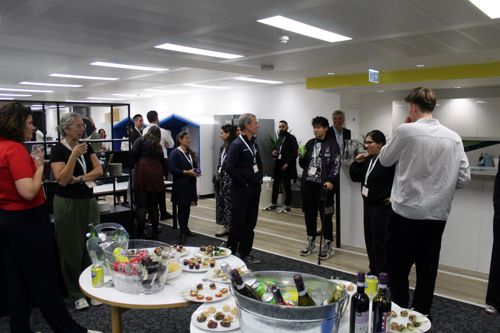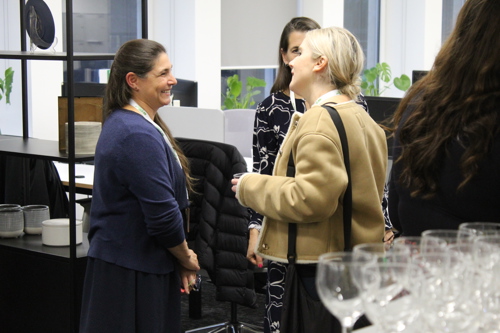
Make it Matter: Turning Environmental Goals into Actions – a recap
A recap of the discussion from the Sports Governance Academy and the Sport and Recreation Alliance's co-hosted networking event, bringing together the sector to connect and to discuss how to turn environmental goals into action.
Date: 14th Oct 2025
Author: SGA and The Sport & Recreation Alliance
Last week, the Sports Governance Academy and the Sport and Recreation Alliance co-hosted a networking event in London, bringing together the sector to connect and to discuss how to turn environmental goals into action. A thought-provoking panel conversation featured experts working at the heart of sustainability in sport, sharing their backgrounds in promoting environmental action and the positive, practical steps that organisations can take to embed sustainability into their everyday operations.
We were delighted to hear from: Tabatha Barton, Director at British Fencing; Caroline Carlin, Member Engagement Manager at BASIS, and Jack Baker, Head of Public Policy and Sustainability at the LTA.
Following an introduction by the co-hosts, the panel, expertly chaired by the SGA’s Sam Green-Armytage, explored importance of sustainability and key learnings from their own experiences.

Why does it matter?
The evening’s discussion focused primarily on two themes: the impact that climate change is having on the sport and physical activity landscape and accepting responsibility for how sport affects the world around it – and how to work towards reducing this.
Impact
We heard in stark terms how sport is already feeling the impact of adverse weather conditions. From news stories about Wimbledon spectators struggling in the heat or the current playing conditions for elite athletes on the Asian tennis tour to the grassroots facilities that are often sited in areas of high flood risk or to the deterioration in air quality, environmental change is affecting the whole sector. And the concern is both that the impacts will get worse and that the negative effects will not be felt equally, hitting more harshly already under-served communities where high levels of inactivity persist.
Large and small, organisations are facing up to the reality that climate change poses threats to participation levels, the staging of events, business models and strategic plans. Nor does sport exist in a vacuum: when asked how an indoor sport such as fencing feels this change, Tabatha Barton provided the perfect response, arguing that ‘every fencer is affected by the climate crisis because every human is impacted’.
Responsibility
The panellists spoke of the role of sport in tackling the problem, both in terms of mitigating its own impacts, and of harnessing its unique profile and reach to advocate for change.
Whereas environmental sustainability is still sometimes seen as a nice-to-have, secondary to other considerations, there is a growing realisation that sport needs to accept that it contributes to the problem and must seize the opportunity to be part of the solution. How organisations continue to deliver on their objectives, to support peak performance or spread the uptake of their sport while reducing the impact on the world around them will continue to be a challenge all must grapple with. This requires them to look at what they do and how they do it, understanding what is within their operational control, changes they can make alone and areas where they will need to work with others. One can’t stop the Australian Open being held in Australia, it was pointed out, and many sports necessitate overseas travel for events and ranking points, but care can be taken when planning calendars so that the sector’s footprint is reduced as far as possible. And there is plenty that is in the gift of our organisations to change.
Here, the scope of opportunity for action is huge: from the mass events of elite sport to simple steps to reduce energy consumption, water usage or single-use plastics in the smaller venues of grassroots activity. The common factor is the acceptance of responsibility.
The panel agreed that the reach and profile of sport is one of its most effective weapons in the drive to promote sustainability. Through its ability to mobilise communities, members, participants and venues, sport occupies a unique position from which advocate for action, influence conversations and provide nudges for behavioural change. Pledgeball and Planet League were cited as examples of successful engagement initiatives aimed at incentivising change.

It feels so big, what can I do?
The problem, of course, can feel overwhelming. Particularly when juggling competing priorities. Yet, the many small steps that we can all take add up to something significant.
The first of these steps is often to gain a better understanding your organisation’s activities and the impact they are having. For some, this will be an eye-opener. Caroline Carlin pointed out that ‘once you take the blinkers off, you can’t unsee the impact”. In measuring that which they are able to measure, organisations can begin to dig into the effects their operations have, better understand their own aims and how the two can be aligned. The metrics to be used and the sort of data that will be needed can be refined as progress is made. The first step is often the hardest.
Jack Baker talked us through the LTA’s Environmental Sustainability Plan, which sets out the Association’s vision for its role on climate action, resource efficiency and reducing its impact on the natural environment. The plan establishes the LTA’s commitments in its various roles as an organisation in its own right, as an event owner and operator, and as the national governing body for tennis in Britain. Jack shared some thoughts on the areas which the LTA themselves control, and those where they need to work with others:
-
Procurement – Embedding sustainability into the tendering process and decision making. This could involve working with supplier and partners to minimise negative effects. Many who deal with NGBs are used to requests for information about their impacts and practices and are open to the insertion of clauses into contracts.
-
Governance – Putting sustainability at the core of business strategy. The LTA has also been able to cascade considerations throughout its national structure via the County Governance Framework.
-
Facilities – Controlling the use of resources and the integration of biodiversity and environmental quality into facilities management.
-
Major events – Promotion of access via public transport, removal of physical tickets, implementation of waste segregation both in front-of-house and -back-of-house operations as a few examples.
From the perspective of a smaller NGB, Tabatha shared some simple steps that have been taken at British Fencing, from kit sharing initiatives to the creation of an environmental checklist for venues, a practical tool that applies a strategic objective without additional burdens on organisers.

Sustainability and governance
The discussion then turned to the role played by governance. Requirement 5.2 in the Code for Sports Governance and commitments such as Sport England seeking environmental action plans from funded partners have certainly focused minds in boardrooms.
The panellists agreed that having an engaged, invested board is a huge factor and key to organisation-wide buy-in. While the board is not necessarily involved in the day-to-day of operations, a degree of sustainability literacy is important to its effective oversight of an environmental strategy, the alignment of activity with commitments and its understanding of the information presented to it by leadership teams or sustainability working groups.
Aligning a sustainability action plan with wider organisational goals is important in successfully embedding it throughout different teams and operations. This can help to raise engagement levels which in turn drives buy-in and encourages stakeholders to contribute to the evolution of the plan. Done correctly, it might even be that initiatives can be funded by other departments in the organisation! For example, effectively communicating the commercial benefits of a well-designed travel initiative – bringing participants or spectators from a wider catchment area, thus creating new membership or spending opportunities – might make enough to sense to a commercial department for them to invest in the project from their budget.

Top tips
-
Understand the ‘why’ and form your narrative around the benefits – for the sport, your stakeholders and the wider community.
-
Communication and engagement are key, both internally and externally. Adapt the approach according to difference audiences – do you need to frame the conversation in terms of commercial advantages, the potential risks to the sport, regulatory consideration such as Code compliance, the expectations of colleagues, participants or fans (especially the younger, more environmentally engaged)?
-
Use the voice of players and athletes – they are role models who can exploit their platform. But ensure that it is authentic.
-
Don’t assume that the existence of a policy will automatically ensure change – make sure that policies are lived in the operations and activities of the organisation.
-
When making changes, engage with stakeholders – explain why you want to do things differently, prepare the way with reference to their own roles, and make sure that objectives are aligned.
-
Get the leadership on board.
-
Meet your stakeholders where they are. Understand that everyone is at a different stage on the journey. Be sympathetic to the other pressures that are at play and be mindful that what works for one group (e.g. elite sport) may not be applicable to another (e.g. grassroots).
-
Provide access to training, education and personal development. Maybe even integrate sustainability action into role descriptions and performance reviews.
-
Measure what you can – and improve your data collection.
-
Learn from what has gone well, and what hasn’t.
-
Just do something…big or small!!
The SGA and the Sport and Recreation Alliance are hugely grateful to Jack, Tabatha and Caroline for giving up their time, and to everyone who came along, took part in conversations and hopefully took away some great ideas and made some valuable connections.
Through its partnership with Sport England, BASIS provides free, tailored support to all system partners helping them to build knowledge, confidence and capability to take credible action on sustainability. Click the button below to find out more.
Found out more about the BASIS offering